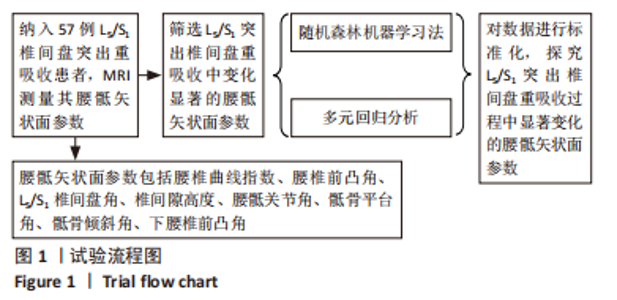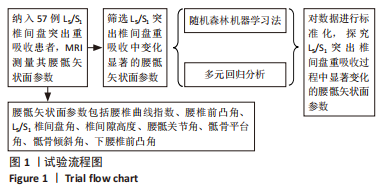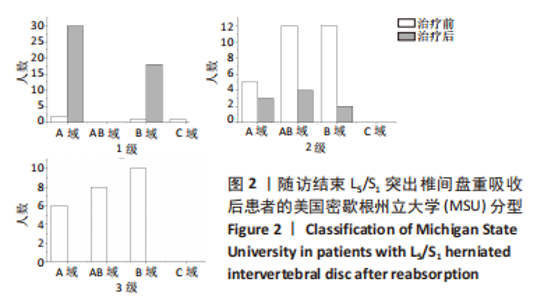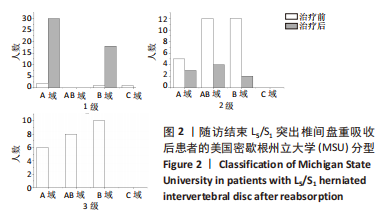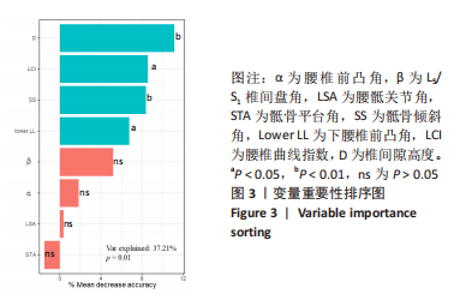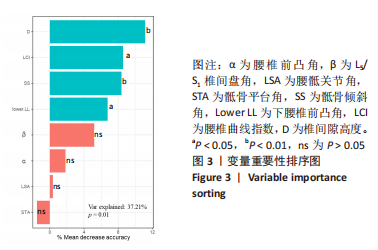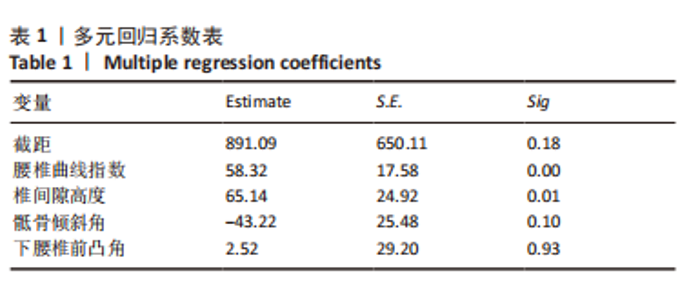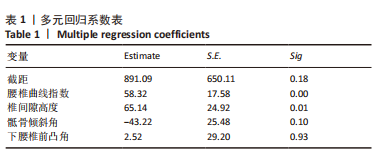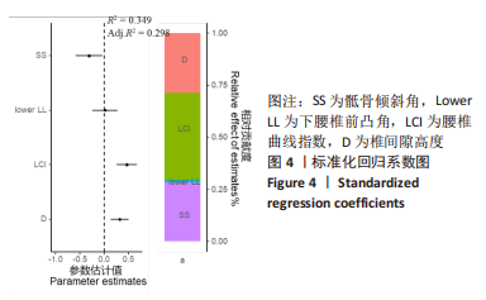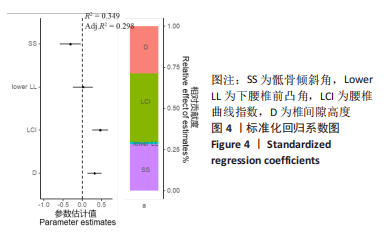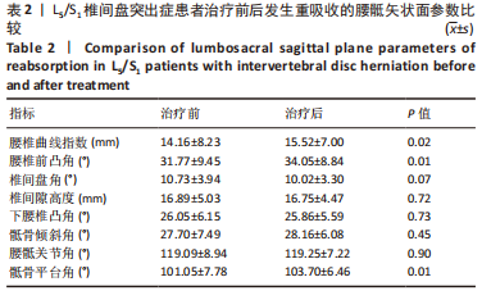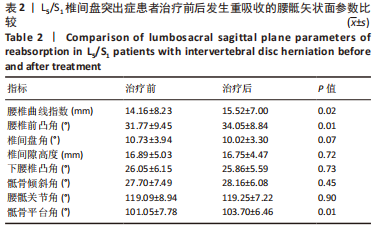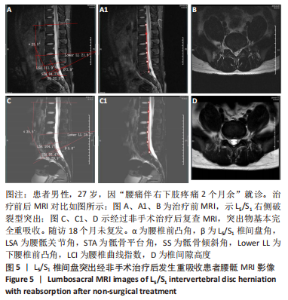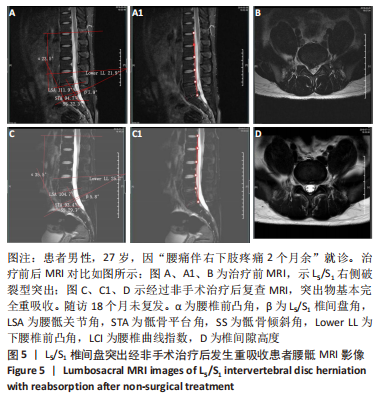[1] DAMMERS R, KOEHLER PJ. Lumbar disc herniation: level increases with age. Surg Neurol. 2002;58(3-4):209-212;discussion 12-13.
[2] 周谋望, 岳寿伟, 何成奇, 等. “腰椎间盘突出症的康复治疗”中国专家共识[J]. 中国康复医学杂志,2017,32(2):129-135.
[3] 孙晨, 孙志波, 禹志宏, 等. 极外侧腰椎间盘突出症的诊断与治疗进展[J]. 中国骨与关节损伤杂志,2018,33(1):106-109.
[4] 马智佳, 俞鹏飞, 刘锦涛, 等. 巨大型腰椎间盘突出症保守治疗的影像学转归及诊疗意义[J]. 颈腰痛杂志,2022,43(5):626-630.
[5] 俞鹏飞, 姜宏, 马智佳, 等. 增强MRI对脱出和游离型腰椎间盘突出症转归的预测价值[J]. 中华骨科杂志,2021,41(18):1350-1360.
[6] 申成春, 张峰, 陈云琳, 等. 增强MRI对脱出和游离型腰椎间盘突出症转归的预测临床价值[J]. 医学影像学杂志,2022,32(4):709-712.
[7] 王丰, 戴国钢, 夏娇, 等. 腰椎矢状面平衡重塑对腰椎间盘破裂突出后自然吸收的影响[J]. 海南医学院学报,2020,26(13):1028-1032.
[8] CUÉLLAR AC, KJÆR LJ, BAUM A, et al. Modelling the monthly abundance of Culicoides biting midges in nine European countries using Random Forests machine learning. Parasit Vectors. 2020;13(1):194.
[9] 宋欠欠, 李轶群, 侯艳, 等. 随机森林的变量捕获方法在高维数据变量筛选中的应用[J]. 中国卫生统计,2015,32(1):49-53.
[10] MYSLIWIEC LW, CHOLEWICKI J, WINKELPLECK MD, et al. MSU classification for herniated lumbar discs on MRI: toward developing objective criteria for surgical selection. Eur Spine J. 2010;19(7):1087-1093.
[11] 吴超, 谭伦. 腰椎矢状曲度的研究进展[J]. 中国矫形外科杂志, 2010,18(5):393-396.
[12] GUINTO FC JR, HASHIM H, STUMER M. CT demonstration of disk regression after conservative therapy. AJNR Am J Neuroradiol. 1984; 5(5):632-633.
[13] TURK O, ANTAR V, YALDIZ C. Spontaneous regression of herniated nucleus pulposus: The clinical findings of 76 patients. Medicine. 2019; 98(8): e14667.
[14] OKTAY K, OZSOY KM, DERE UA, et al. Spontaneous regression of lumbar disc herniations: A retrospective analysis of 5 patients. Niger J Clin Pract. 2019;22(12):1785-1789.
[15] HENMI T, SAIRYO K, NAKANO S, et al. Natural history of extruded lumbar intervertebral disc herniation. J Med Invest. 2002;49(1-2):40-43.
[16] HA KY, KIM BG, KIM KW, et al. Apoptosis in the sequestrated nucleus pulposus compared to the remaining nucleus pulposus in the same patient. Spine. 2011;36(9):683-689.
[17] RAJNICS P, TEMPLIER A, SKALLI W, et al. The importance of spinopelvic parameters in patients with lumbar disc lesions. Int Orthop. 2002;26(2): 104-108.
[18] 袁海波, 李东亚, 潘彬, 等. 高位腰椎间盘突出症矢状面相关因素分析[J]. 中国组织工程研究,2023,27(31):4984-4989.
[19] 戴国钢, 王丰, 刘磊, 等. 矢状面平衡参数与脱出腰椎间盘重吸收关系的回顾性研究[J]. 四川大学学报(医学版),2020,51(4):533-539.
[20] 陈晓荣, 秦少华, 周林江, 等. 腰椎间盘突出症突出物自然吸收与腰椎曲度的相关性研究[J]. 安徽医药,2022,26(9):1839-1842.
[21] 毕是昊, 于功昌, 栗子渊, 等. 基于MRI成像三维平衡正脊技术治疗LDH髓核重吸收的预测因素分析[J]. 中国辐射卫生,2022,31(4): 482-487.
[22] LIU H, LI S, ZHENG Z, et al. Pelvic retroversion is the key protective mechanism of L4-5 degenerative spondylolisthesis. Eur Spine J. 2015; 24(6):1204-1211.
[23] ANDREASEN ML, LANGHOFF L, JENSEN TS, et al. Reproduction of the lumbar lordosis: a comparison of standing radiographs versus supine magnetic resonance imaging obtained with straightened lower extremities. J Manipulative Physiol Ther. 2007;30(1):26-30.
[24] FERNAND R, FOX DE. Evaluation of lumbar lordosis. A prospective and retrospective study. Spine. 1985;10(9):799-803.
[25] 邵福元, 邵华磊. 颈肩腰腿痛应用检查学[M]. 郑州:河南科学技术出版社,2002:255.
[26] BOWDEN JA, BOWDEN AE, WANG H, et al. In vivo correlates between daily physical activity and intervertebral disc health. J Orthop Res. 2018;36(5):1313-1323.
[27] GAWRI R, ROSENZWEIG DH, KROCK E, et al. High mechanical strain of primary intervertebral disc cells promotes secretion of inflammatory factors associated with disc degeneration and pain. Arthritis Res Ther. 2014;16(1):R21.
[28] PARK JB, KIM KW, HAN CW, et al. Expression of Fas receptor on disc cells in herniated lumbar disc tissue. Spine. 2001;26(2):142-146.
[29] ZHU Y, LIU JT, YANG LY, et al. p38 mitogen-activated protein kinase inhibition modulates nucleus pulposus cell apoptosis in spontaneous resorption of herniated intervertebral discs: An experimental study in rats. Mol Med Rep. 2016;13(5):4001-4006.
[30] CHEN S, FU P, WU H, et al. Meniscus, articular cartilage and nucleus pulposus: a comparative review of cartilage-like tissues in anatomy, development and function. Cell Tissue Res. 2017;370(1):53-70.
[31] HAYASHI K, SUZUKI A, ABDULLAH AHMADI S, et al. Mechanical stress induces elastic fibre disruption and cartilage matrix increase in ligamentum flavum. Sci Rep. 2017;7(1):13092.
[32] 谢玮慧, 白萌, 汪翔, 等. 骶骨形态与L5/S1椎间盘突出的关系[J]. 南昌大学学报(医学版),2017,57(3):52-55.
[33] 周永富, 常晓涛, 武凯, 等. 腰骶角和腰椎曲度的相关性研究[J]. 中国实用医药,2019,14(36):14-16.
[34] 曹毅, 万业达, 李宝玖, 等. 站立位与卧位X线摄影对腰椎曲度测量影响的研究[J]. 天津医科大学学报,2015,21(2):158-160.
[35] LEE ES, KO CW, SUH SW, et al. The effect of age on sagittal plane profile of the lumbar spine according to standing, supine, and various sitting positions. J Orthop Surg Res. 2014;9(1):11.
[36] 刘湘, 赵晓东, 龙耀武, 等. 腰椎间盘突出症严重程度与腰椎曲度相关性的影像学研究[J]. 广东医学,2017,38(24):3824-3826+3830.
[37] 马文玲, 董馥闻, 王玉玲, 等. MRI腰椎曲度参数对腰椎间盘突出症患者椎间孔镜术后疗效的评价[J]. 中国中西医结合影像学杂志, 2022,20(3):273-275.
[38] 刘锦涛, 姜宏, 徐坤林, 等. 非手术疗法对腰椎间盘突出后重吸收的影响(附30例分析)[J]. 中国骨与关节损伤杂志,2010,25(11): 978-980.
|
